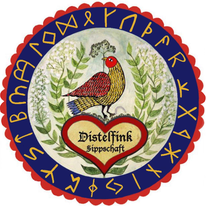Today I was driving up to the Urglaawe cemetery on back roads. It was a nice day to drive after several days of heavy rain. I noticed that the Hollenbach (the Deitsch name for Jordan Creek in Lehigh County, PA) was flowing particularly strongly (and it normally is pretty fast to begin with), so I pulled onto a side road, got out of my truck, and walked onto a bridge that looks over the creek.
While I was standing there, an old man walked up from the side road carrying fishing gear. He greeted me, and we struck up a conversation. Through the course of the chat, I mentioned the Urglaawe Folklore Research Project, which interested him immensely. This part of Lehigh County is Blobarrick (Blue Mountain) country and is thus Ewicher Yeeger's stomping grounds.
I asked him if he knew any folk stories from the region, and he replied that he did. When I mentioned Ewicher Yeeger, his face lit up, and he said that he knew a few stories. One that he told was very similar to the Ewicher Yeeger story of Allemaengel, but then he told me an anecdote that I found interesting.
He said that when he was a boy, his brother, some friends, and he used to fish in the Hollenbach, and there was an old man, whose name he could not recollect, who used to fish in the creek as well. He said the old man was very mysterious and he was not sure of much about him other than that he was from Werleseck (Werleys Corner) and that people considered him to be a hermit. The old man would talk to the boys and would tell them stories about the area (some of which he related to me).
He said that what he recalled vividly was that he thought some of the man's actions were peculiar. He would throw beans, corn, worms, flowers or plants, cheese, or other items into the creek before and/or after he fished, whether he caught something or not. He said that when the old man would catch a fish, he would utter a word of thanks to the Eternal Hunter for giving him a meal that night. He would then throw some food into the creek for the fish.
When I remarked on only having heard of Ewicher Yeeger in the context of the hunt, he replied, "Fishing is a bit like hunting, gell?"
He then remarked that he thinks of the mysterious old man occasionally when he is fishing or when he walks past the area where the old man used to fish. We continued to to talk as we walked along the creek so he could show me where the man used to fish, and he admitted that he on occasion whispers a thanks to Ewicher Yeeger when he catches a fish or has a successful hunt.
The description given to me about the mysterious man indicates that he was a Braucher or a Hex and that the man relating this story to me was witnessing the hermit's rituals. The man with whom I was speaking was born "during the time that the people were depressed" so he is likely at least in his 80s, and he said the hermit was very old when he was about age 11-15 or 16. This would put the hermit as being born sometime, perhaps during the 1850s-1870s.
The man said he would ask his brother if he remembered any other stories that the old man or anyone else told when they were boys and he'd contact me if he learned anything.

